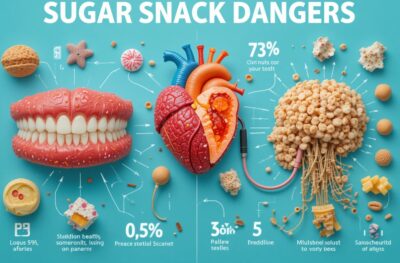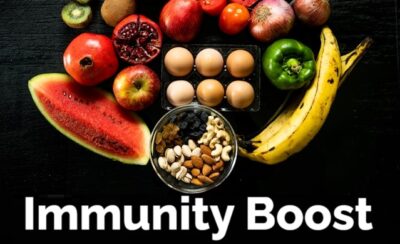Are Sugar Snack Dangers Real?
The modern diet faces a critical challenge with Sugar Snack Dangers permeating our daily meals. In today’s fast-paced world, people often reach for quick, tasty solutions, yet the constant consumption of sugary snacks exposes them to several adverse effects. In this comprehensive article, we explore what sugary snacks are, detail how Sugar Snack Danger affect various aspects of the body, and provide you with practical, step-by-step guidance on how to identify and mitigate these health risks. Throughout the discussion, you will notice the recurring reminder of Sugar Snack Danger—a phrase that encapsulates the potential risks posed by these widely consumed treats.
In the upcoming sections, we will explain in detail:
- What are sugary snacks?
- Why are Sugar Snack Dangers a serious matter?
- How do they influence each bodily system?
Moreover, we focus on actionable steps on how to understand and counter these Sugar Snack Danger while ensuring that the approach is clear, engaging, and practical for a global audience. Let’s get started on this journey toward a healthier lifestyle while making sure the content respects universal values and cultural sensitivities.
Table of contents
- Are Sugar Snack Dangers Real?
- 1. What Are Sugary Snacks?
- 2. Why Should You Be Concerned About Sugar Snack Dangers?
- 3. How Do Sugar Snack Dangers Affect Specific Body Systems?
- 4. How Can You Overcome Sugar Snack Dangers?
- 5. What Do Studies and Data Say About Sugar Snack Dangers?
- 6. How Do You Implement a Healthier Lifestyle to Combat Sugar Snack Dangers?
- 7. What Are the Long-Term Outcomes of Overcoming Sugar Snack Dangers?
- Conclusion
1. What Are Sugary Snacks?
1.1 What Constitutes Sugary Snacks?
Sugary snacks refer to a broad category of food items that contain high levels of sugars and simple carbohydrates. These include:
- Candy, chocolate bars, and jellies
- Sweetened baked goods such as cupcakes and cookies
- Sugary cereals
- Dessert snacks like puddings and flavored yogurts
Each of these items provides quick energy, but the rapid spikes in blood sugar levels also underline the inherent Sugar Snack Danger. Therefore, understanding the composition and variety of sugary snacks is crucial if you are to take control over your dietary choices.
1.2 How Are They Processed and Marketed?
Manufacturers often enhance these products using food additives and artificial flavorings, which can intensify the experience of taste but also mask the inherent Sugar Snack Danger. As a result, consumers—particularly children and young adults—tend to opt for these products, sometimes unaware of their cumulative negative impact on the body.
- Rapid energy boost: These snacks provide an almost immediate surge in blood sugar.
- Addiction and craving cycles: The continuous exposure leads to cravings and dependency.
- Hidden sugars: Even items that are not overtly “sweet” may contain added sugars that contribute to Sugar Snack Danger.
1.3 How Do Cultural and Social Factors Contribute?
Cultural norms and marketing strategies play a significant role in the prevalence of sugary snacks globally. While certain marketing approaches are designed to appeal emotionally—through vibrant packaging and persuasive messaging—the public often remains unaware of the long-term Sugar Snack Danger. Therefore, consumers need to educate themselves on distinguishing between occasional indulgence and habitual consumption that poses serious health hazards.
2. Why Should You Be Concerned About Sugar Snack Dangers?
2.1 What Are the Immediate Effects on the Body?
When you consume sugary snacks, your body reacts almost instantly:
- Blood Sugar Surge: Rapid absorption of sugars triggers a sharp spike in blood glucose, followed by an equally rapid decline. Consequently, the fluctuating energy levels remind us that Sugar Snack Danger are not only short-term but also pave the way for chronic conditions.
- Insulin Response: Your pancreas releases insulin to manage these spikes, and when faced with frequent exposure, it struggles to keep up, contributing to overall Sugar Snack Danger.
- Inflammation: Inflammatory markers may increase within minutes after consumption, causing discomfort and a potential long-term strain on the immune system, thereby spotlighting the Sugar Snack Danger.
2.2 How Do Sugary Snacks Impact Long-Term Health?
Moreover, regular consumption of high-sugar snacks can eventually lead to:
- Chronic Diseases: Sugar Snack Dangers include an increased risk of Type 2 Diabetes, cardiovascular issues, and metabolic syndrome.
- Dental Issues: Constant exposure to sugar erodes tooth enamel, causing cavities and gum infections. As such, Sugar Snack Danger manifests quite evidently in dental health.
- Mood Fluctuations: The cycle of high energy bursts followed by crashes may contribute to mood swings and irritability, indicating that the Sugar Snack Danger stretch into mental health concerns.
- Weight Gain and Obesity: Overconsumption of sugary snacks leads to an imbalance in calorie intake, raising the specter of obesity—a major component of Sugar Snack Danger that affects people of all ages.
2.3 How Can You Recognize Sugar Snack Dangers Early?
Recognizing the risks is the first step in protecting yourself. Ask yourself:
- Do you feel extreme fatigue after consuming these snacks?
- Are you experiencing frequent dental problems?
- Is your mood unusually erratic on snack-heavy days?
If the answer is yes, it becomes evident that Sugar Snack Danger is present in your lifestyle, and you must adopt preventive measures as explained in later sections.
3. How Do Sugar Snack Dangers Affect Specific Body Systems?
3.1 How Do Sugar Snack Dangers Impact Dental Health?
Sugar Snack Danger create a perfect environment for bacterial growth in your mouth. When sugars mix with saliva, they form acids that erode tooth enamel. Here’s how to protect your dental health:
- Brush your teeth frequently with fluoride toothpaste.
- Use mouthwash to reduce bacterial presence.
- Limit snacking between meals to minimize acid attacks.
These practices reduce Sugar Snack Danger by ensuring that sugar residues are quickly cleared from the mouth.
3.2 How Do Sugar Snack Dangers Influence the Digestive System?
Your digestive system responds to sugary snacks in multiple ways:
- Gut Flora Imbalance: Excess sugar can disturb the natural balance of beneficial bacteria in the gut, fostering the growth of harmful microbes.
- Digestive Discomfort: Many people experience bloating, gas, or irregular bowel movements due to Sugar Snack Dangers introduced by overconsumption.
- Inflammatory Responses: Chronic inflammation in the gastrointestinal tract may occur, linking Sugar Snack Danger with conditions such as irritable bowel syndrome (IBS).
To alleviate these issues, incorporate fiber-rich foods and probiotics into your diet, which help counteract the Sugar Snack Dangers in your digestive tract.
3.3 What Are the Cardiovascular Consequences of Sugar Snack Dangers?
The heart and blood vessels bear significant impacts from habitual sugar intake:
- Increased Triglycerides: High sugar consumption leads to elevated triglyceride levels in the blood.
- High Blood Pressure: These changes strain the cardiovascular system, intensifying Sugar Snack Danger.
- Plaque Buildup: Repeated sugar spikes may contribute to the formation of plaque in the arteries, which is a direct manifestation of Sugar Snack Danger.
In order to mitigate these risks, combine regular physical activity with a balanced diet that minimizes sugar intake.
3.4 How Do Sugar Snack Dangers Affect Metabolic Health and the Endocrine System?
Sugar Snack Dangers include the destabilization of your metabolic processes:
- Insulin Resistance: Frequent sugar spikes foster a condition wherein your body no longer responds effectively to insulin.
- Obesity Risk: These metabolic disturbances escalate calorie storage as fat, emphasizing the Sugar Snack Danger.
- Hormonal Imbalances: The endocrine system may falter, and hormone levels can fluctuate, which further illustrates the widespread Sugar Snack Dangers.
To counteract these challenges, focus on a diet that emphasizes whole grains, lean proteins, and healthy fats to reduce the impact of Sugar Snack Dangers on your metabolism.
3.5 How Do Sugar Snack Dangers Affect Brain Function and Mental Health?
Emerging research indicates that excessive sugar intake can undermine brain health:
- Cognitive Impairment: Studies have linked poor dietary habits to reduced cognitive functions. The persistent Sugar Snack Dangers stress the brain over time.
- Mood Instability: Sudden fluctuations in blood sugar can lead to mood changes, anxiety, and stress.
- Neurotransmitter Imbalance: Over time, Sugar Snack Danger might affect the production and balance of neurotransmitters, which influence overall mental clarity and emotional stability.
In addition, incorporating activities that promote mental well-being, such as regular exercise and mindfulness, may help relieve some of the Sugar Snack Dangers that impair cognitive and emotional functions.
3.6 How Do Sugar Snack Dangers Impact Skin Health?
Your skin reflects the internal state of your health. Sugar Snack Danger contribute to several skin-related issues:
- Acne and Breakouts: High sugar intake increases oil production and inflammation, leading to acne.
- Premature Aging: Glycation—a process enhanced by excess sugar—damages collagen and elastin fibers, which accelerates the aging process and intensifies Sugar Snack Danger.
- Inflammation: Red, irritated, or sensitive skin may result from chronic inflammation spurred by Sugar Snack Dangers.
A diet rich in antioxidants, vitamins, and adequate hydration can help counterbalance Sugar Snack Dangers affecting the skin.
4. How Can You Overcome Sugar Snack Dangers?
4.1 What Are the Practical Steps to Reduce These Dangers?
Addressing Sugar Snack Dangers requires concrete, actionable steps. Here are some approaches:
- Plan Your Meals
- Prepare healthy snacks such as fruits, nuts, or yogurt.
- Create a meal schedule that minimizes impulsive snacking and, therefore, reduces Sugar Snack Danger.
- Read Food Labels
- Check for hidden sugars in packaged foods.
- Understand ingredient lists to avoid products that intensify Sugar Snack Dangers.
- Set Clear Goals
- Establish daily or weekly limits on sugar consumption.
- Track your progress using journals or mobile apps to monitor reductions in Sugar Snack Dangers.
- Increase Awareness
- Educate yourself on nutrition and the implications of high sugar intake.
- Participate in community or online groups that share information about combating Sugar Snack Danger.
4.2 What Are the Alternative, Healthier Choices?
To diminish Sugar Snack Dangers, you can easily replace high-sugar options with healthier alternatives:
- Fruits and Vegetables: They provide natural sugars along with fiber, vitamins, and minerals.
- Whole Grains and Legumes: These choices stabilize blood sugar levels and lower the risk of Sugar Snack Danger.
- Natural Sweeteners: Opt for honey or dates in moderation, but do so with the understanding that excessive use contributes to Sugar Snack Danger.
- Nuts and Seeds: They offer satisfying crunch and essential fats without overwhelming your system with sugar.
4.3 How Can You Build Sustainable Habits?
Building a lifestyle that minimizes Sugar Snack Danger involves consistency and adaptability. Consider these strategies:
- Establish a Routine: Engage in consistent meal planning and maintain regular physical activity.
- Monitor Your Health: Keep an eye on weight, mood, and energy levels, which serve as indicators of Sugar Snack Danger.
- Seek Professional Advice: Consult nutritionists or healthcare professionals if you suspect that the Sugar Snack Danger have significantly impacted your wellbeing.
- Embrace Mindful Eating: Practice mindfulness during meals to enhance your awareness of the foods you consume and gradually reduce Sugar Snack Danger.
5. What Do Studies and Data Say About Sugar Snack Dangers?
5.1 Which Research Studies Highlight the Impact?
Several studies and data sets underscore the risks associated with excessive consumption of sugary snacks:
- The World Health Organization (WHO) has reported that overconsumption of sugars increases the risk of obesity, diabetes, and dental problems—key aspects of Sugar Snack Danger.
- Research published in journals such as The American Journal of Clinical Nutrition shows that high sugar intake triggers inflammatory responses and metabolic disturbances, which are central to the Sugar Snack Dangers.
- Public health institutions worldwide have issued guidelines to limit sugar intake, underscoring the necessity of countering Sugar Snack Dangers for long-term health.
5.2 Can Visual Data Help Illustrate These Dangers?
A well-organized table can facilitate your understanding of the effects of sugary snacks on various body systems:
| Bodily System | Impact | Key Factor of Sugar Snack Dangers |
|---|---|---|
| Dental Health | Tooth decay, cavities, gum disease | Acid formation from sugar breakdown |
| Digestive System | Imbalance in gut flora, bloating, and inflammation | Disruption of beneficial bacteria |
| Cardiovascular System | Increased triglycerides, plaque buildup, high blood pressure | Insulin spikes and chronic inflammation |
| Metabolic Health | Insulin resistance, obesity, hormonal imbalances | Fluctuations in blood sugar levels |
| Brain Function | Cognitive decline, mood instability, neurotransmitter imbalance | Rapid sugar absorption affecting the brain |
| Skin Health | Acne, premature aging, inflammation | Glycation and impaired collagen synthesis |
This table clearly presents how various bodily systems experience Sugar Snack Danger and reinforces the importance of mindful dietary choices.
6. How Do You Implement a Healthier Lifestyle to Combat Sugar Snack Dangers?
6.1 What Are the Benefits of a Balanced Diet?
Transitioning away from sugary snacks not only reduces Sugar Snack Danger but also allows you to enjoy a balanced, nutrient-rich diet. Therefore, aim to:
- Choose Fresh Produce: Natural fruits and vegetables come with fiber, vitamins, and antioxidants.
- Opt for Complex Carbohydrates: Such as whole grains, which provide sustained energy release.
- Include Protein Sources: Lean meats, legumes, and dairy stabilize your metabolism and decrease reliance on sugary energy bursts.
6.2 How Can You Stay Motivated and Monitor Progress?
Adopt strategies that emphasize self-accountability and continuous improvement:
- Set Measurable Goals: For example, reduce overall sugar intake by a specific percentage each month to lessen Sugar Snack Dangers.
- Keep a Food Diary: Document what you eat and when. This practice helps you identify patterns that contribute to Sugar Snack Dangers.
- Celebrate Small Victories: Recognize progress, such as improved dental health or increased energy levels, as positive indicators that you are overcoming Sugar Snack Danger.
6.3 What Role Do Community and Support Systems Play?
Support from family, friends, or online communities can significantly ease the transition:
- Share Recipes and Tips: Join groups or forums where members exchange healthy alternatives that minimize Sugar Snack Dangers.
- Engage in Group Activities: Activities like cooking classes, healthy eating workshops, and community sports can promote a collective effort to counter Sugar Snack Danger.
- Consult with Experts: Seek advice from nutritionists who help tailor diets specifically designed to reduce Sugar Snack Danger while maintaining a balanced nutrition.
7. What Are the Long-Term Outcomes of Overcoming Sugar Snack Dangers?
7.1 How Does a Reduced Sugar Intake Improve Overall Wellbeing?
Reducing the intake of sugary snacks results in numerous benefits:
- Stable Energy Levels: By avoiding the peaks and valleys of sugar highs, you experience sustained energy throughout the day, alleviating Sugar Snack Danger.
- Improved Mental Clarity: Stabilized blood sugar levels help maintain focus, reducing the cognitive impacts associated with Sugar Snack Danger.
- Enhanced Physical Fitness: With better metabolic function and weight management, your body becomes more resilient against the harmful Sugar Snack Danger.
- Better Immune Response: Lower inflammation levels lead to a stronger immune system, which in turn minimizes the overall Sugar Snack Danger.
7.2 What Do Global Health Experts Recommend?
Prominent health organizations continue to provide guidelines to minimize Sugar Snack Danger:
- The WHO recommends that adults limit their daily sugar intake to less than 10% of their total energy consumption.
- Nutrition experts also advise emphasizing whole, unprocessed foods, which substantially lowers the risks associated with Sugar Snack Danger.
- Longitudinal studies demonstrate that societies with lower sugar consumption enjoy a reduced incidence of metabolic and cardiovascular diseases—an essential strategy against Sugar Snack Danger.
Conclusion
Adopting a proactive stance toward Sugar Snack Dangers can transform your health trajectory significantly. This article has examined, in detail, what sugary snacks are, how they imperil your body from dental issues to metabolic dysfunction, and what practical steps you can take to safeguard your well-being. Are you ready to reclaim control over your nutritional habits and dramatically reduce Sugar Snack Dangers in your life?
By integrating healthier alternatives, maintaining a balanced diet, and remaining aware of the risks highlighted by Sugar Snack Dangers, you can forge a path toward long-lasting health improvements. Remember that every choice counts, and every step toward reduction is a step away from the adverse consequences associated with sugary snacks.
We encourage you to reflect on the questions posed throughout this article. Have you observed the impacts of Sugar Snack Dangers in your daily routines? What small changes might you implement immediately to begin reducing your sugar intake? Your journey to improved health starts with informed choices that address Sugar Snack Dangers head of.
Source Article and Study Links (Direct URLs with details):
Source 3:
Name: Oral Health Fast Facts
Date: 2021
Author: Centers for Disease Control and Prevention (CDC)
Link: https://www.cdc.gov/oralhealth/fast-facts/index.html
Source 1:
Name: Healthy Diet – WHO Fact Sheet
Date: June 2020
Author: World Health Organization
Link: https://www.who.int/news-room/fact-sheets/detail/healthy-diet
Source 2:
Name: Added Sugars and Cardiovascular Disease Risk in Youth
Date: 2019
Author: M. Vos et al.
Link: https://academic.oup.com/ajcn/article/109/3/678/5363565






